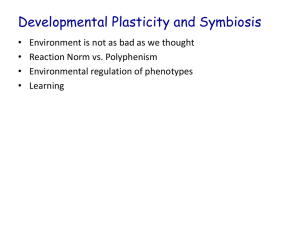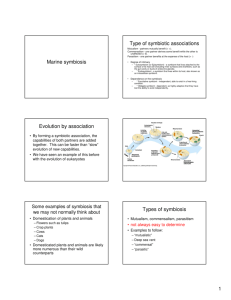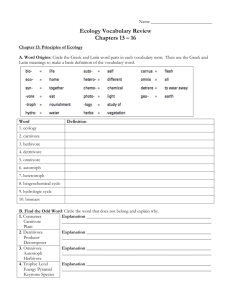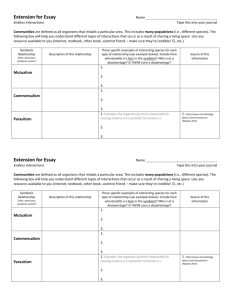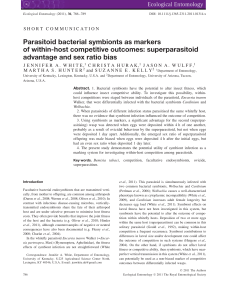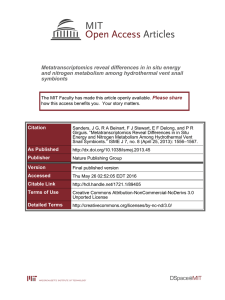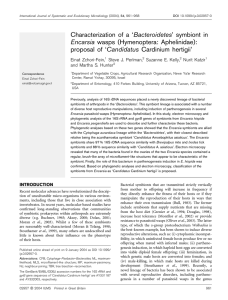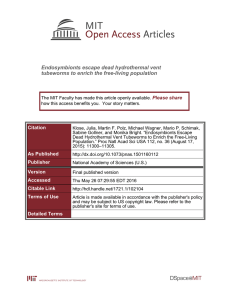symbiosis - Cal State LA - Instructional Web Server
advertisement
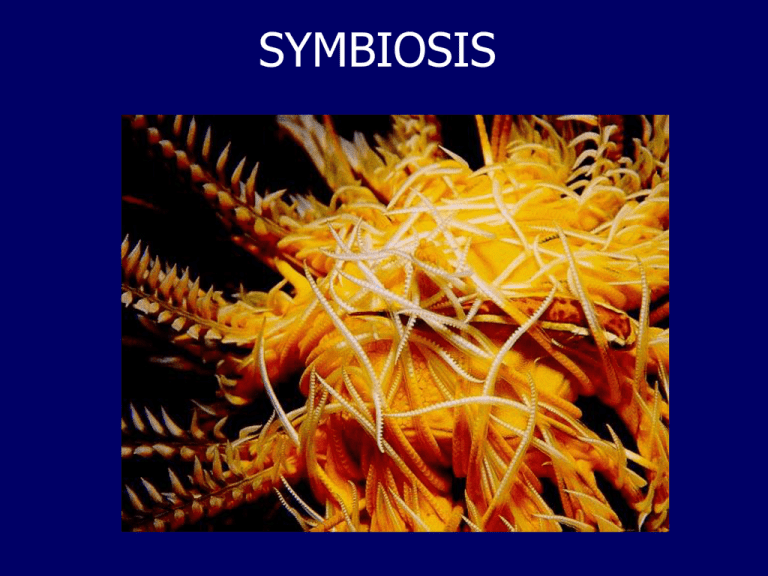
SYMBIOSIS Definition of Symbiosis • Symbiosis is a set of species interactions involving close physical association of participants, and frequently, evidence of co-evolution. • Symbiotic interactions maybe exploitative or cooperative. Cooperative interactions are thought to have evolved from exploitative interactions when benefits outweighed costs for both partners. • There are 3 types of symbiotic interaction: parasitism, commensalism, and mutualism. Significance of symbiosis • Of the three types of symbiotic interactions, two are cooperative, rather than exploitative. • Many interactions are cryptic and may not produce immediate survival or reproduction, so that how they function in population regulation is poorly understood. • Some historians argue that the “Neo-Malthusian Perspective” has blinded us to the importance of symbiosis. • Examples like hermatypic corals show that entire global ecosystems depend on symbiosis for their existence. Facultative Versus Obligative Symbiosis • FACULTATIVE symbiosis occurs between otherwise free-living partners. Their survival does not depend on the interactions, but fitness changes as a result. • May exist with little co-evolution • No specialized structures assuring the interaction may be present. • In OBLIGATIVE symbiosis, one or both partners must engage in interaction to survive or reproduce. • Elaborate co-evolution often apparent. • Specialized structures or behaviors exist and require energy to develop or maintain. Definitions of Types • Parasitism: A parasite lives in close physical association with a host from which it receives nourishment, lowering the fitness of the host. Exploitation is usually sub lethal. (+/-) • Mutualism. Both “interactors” increase their fitness as a result of the exchange. Mutualism thought to have evolved from parasitism or commensalism. (+/+) • Commensalism: Commensal and host live in close association, with the former receiving nourishment or shelter, without reducing the fitness of the host. Many commensalisms may be cryptic parasitisms or mutualisms. (+/0) Parasitic castration: Sacculina sp. • A highly evolved parasitc barnacle, Sacculina grows within decapod hosts as a branching system of tubules that extract nutrients, diverting most of the hosts energy to its own bulbous reproductive structure on the outside of the host. • Loss of nutrients from host and hormonal releases from the parasite prevent crabs from developing functional gonads. • Crabs become infected when the Sacculina cyprid settles at the base of a bristle and injects a mass of undifferentiated cells into the host blood stream. The cell mass develops into the adult parasite. Commensalisms: Pearl Fish and the sea cucumber Pearl fish seek shelter in the rectum of their sea cucumber hosts. Facultative or Obligative? Micorrhizea: a mutualistic association between plant and root fungus Mutualism Confirmed • Isotopes injected in the vascular system (phloem) of host trees have been traced first to the roots, then to mycorrhizae infecting the roots. The hosts, thus, give nourishment to the fungi. • The following lab experiment is part of the growing evidence that the mycorrhizae confer benefit to their host plants. An Experiment to test (1) whether mycorrhizea help plants acquire nutrients, and if so, (2) whether the fertility of soil determines whether the helpful mycorrhizea are present. Inocula of fungi (treatments) and no inoculum (control) were initiated in nutrient poor soil As a second treatment factor, replicates of inocula received varying amounts of nutrient. (Nutrient additions not shown in figure. See text for details) Results: When nutrients available, mycorrhizea help plants acquire them, grow larger. Results: Increased nutrient uptake by mycorrhizea increases host plant reproduction. Environmental Context • Mycorrhizea are widespread in terrestrial plant communities. • The most common rainforest trees often share the same species of mycorrhizea, suggesting that the association is essential to their success. Coral-Algae Mutualism: a crucial interaction for reef-building corals. Close up of colony showing external anatomy of polyps Anatomy of hermatypic corals. Polyp Algal inclusions In the gastrodermis Theca The algal symbiont • ALgal symbionts are goldenbrown algae, zooxanthelea. • Nearly all symbionts of the large phylum Cnidaria belong to the same genus. Different strains occur in different species or clones. The symbionts are transmitted by adult cnidarians to their embryonic young. Shown is a free living symbiont from culture. Electron micrograph of Symbiodinium in host tissues, highly transformed. Experiment demonstrating that: Symbionts promote rapid skeletal growth of hermatypic corals. Goreau et al. Experiments demonstrating that: Photosynthetic products translocated. Growing tips covered with opaque or clear caps, or uncovered. Growth rates remain same for all three. Autoradiography showed phosphate and Carbon isotopes incorporated into protein and carbohydrates at growing tip. Interpretation? Separate HPLC analyses showed algae leak glucose glycerol and amino acids. Experiments demonstrating that: Symbionts “recognize” hosts. Summary Coral/Algae Mutualism Additional info • About 1/3 protein of host orginates from algal amino acids. • Uptake of CO2 increases PH, allowing faster CaCO3 deposition. • Symbionts release about 50% of what they produce (by weight). • Hosts extracts are interchangable, just as symbiont is not specific to host. A ‘soft coral’: no CaCO3 skeleton, no symbionts. This type of coral does not build reefs. Conclusion • Mutualistic interactions are ancient and widespread. • Matrix forming species (e.g. trees, corals), which are the foundation of important communities, depend for their success on obligative mutualisms. • Therefore, the “struggle for existence” involves both cooperative and exploitative interactions in complex networks that we are only beginning to understand.


